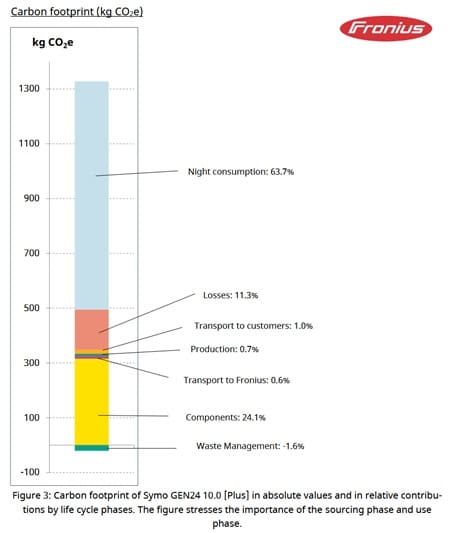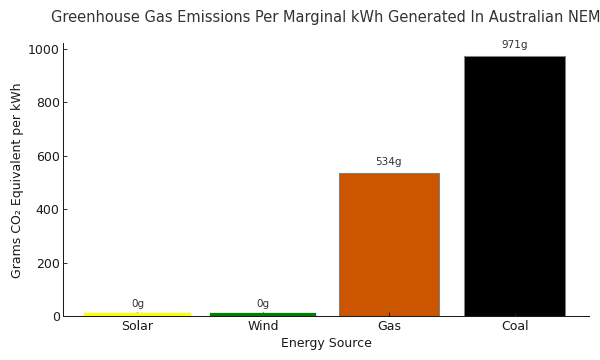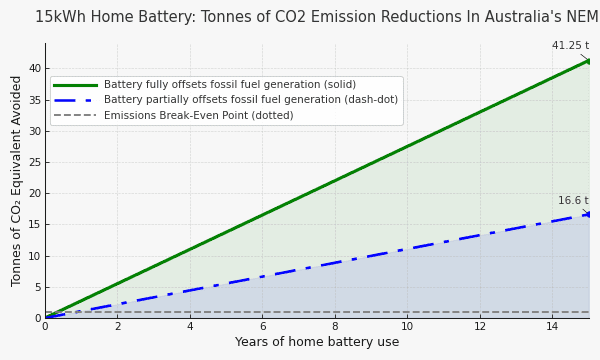
A Sungrow battery installed by I Want Energy.
Here are two facts about home batteries:
- Using a home battery reduces greenhouse gas emissions.
- Making and installing a home battery increases greenhouse gas emissions.
The good news is the first effect is much larger than the second. Pinning down how much home batteries reduce emissions isn’t easy, but I’m going to take a stab at it. Hopefully, by the time you get to the end of this post, you won’t want to take a stab at me.
How Much Do Home Batteries Cut Emissions?
Based on my analysis of Australia’s largest grid, the National Electricity Market (NEM), a typical home battery will pay off its emissions debt in under 18 months. Over its lifespan, a solar battery with 15kWh of usable capacity will cut emissions by more than 10 times the amount caused by its creation and installation, reducing emissions by more than 16 tonnes over a 15 year lifespan.
That’s just for the typical use case of a home battery charged with solar energy that could have been exported to the grid, where it may have reduced fossil fuel generation had the battery not been in use.
If however, a home battery is only charged with solar energy that otherwise would have gone to waste, the climate benefit is far larger, cutting emissions by somewhere around 28 to 1.
These figures don’t include indirect effects on emissions, which my recent analysis shows can offer even greater climate benefits.
Upper & Lower Bounds For Emission Reductions
When a home battery is charged with rooftop solar, it can have one of two effects on emissions:
- Emissions increase because the solar energy would otherwise have been sent into the grid, where it would have reduced fossil fuel generation.
- There’s no effect on emissions because there is already so much clean energy available that some of it is going to waste, or the solar energy wouldn’t have been sent into the grid in the first place.
I’ll start by considering a home battery that never increases fossil fuel generation by being charged. This can happen if a home is zero export limited and can’t send rooftop solar power into the grid, or the solar system produces much more energy than can be exported, allowing the battery to only be charged with clean energy that otherwise would have been wasted.
A Nasty Discharge For Fossil Fuel Generation
When a home battery is discharged at night, it will reduce either coal or gas generation. Renewables normally won’t be affected. This is because coal and gas have fuel costs while wind power’s fuel — moving air — is free. It is possible hydro generation will be cut back, but this leaves water in the dam that will later be used in place of fossil fuels, so it’s always coal and gas that get cut — there’s just a delay sometimes.
Over the past year, 50.3% of Australia’s generation came from coal, while only 7.1% came from gas. This makes it appear that discharging a battery should mostly cut coal, but gas generation is concentrated in the early evening when home batteries do most of their discharging. However, gas generation is in decline and nearly at half of its peak 11 years ago. Batteries are hastening its fall, so I expect a home battery will reduce considerably more coal generation than gas over its lifespan. But to keep things simple, I’ll assume a 50/50 split between gas and coal.
Over the past year, the average emissions from fossil fuels in the National Electricity Market have been:
- Coal: 971g per kWh
- Gas: 534g per kWh
These figures are mostly carbon dioxide (CO2), but also take into account methane leaks and nitrous oxide by adding in an equivalent amount of CO2. This makes them CO2 equivalent emission figures.
With a 50/50 split, the average emissions reduction from discharging 1kWh of battery energy is 753g. If a 15kWh battery were completely discharged overnight, it would lower emissions by 11.3kg. If this were done every night, the emission reductions over 1 year would come to 4.1 tonnes, which is more than the roughly 3 tonnes the average petrol passenger car emits annually. But discharging a home battery’s entire capacity every night isn’t realistic.
Home Battery Capacity
Unless used in a strange way — possibly by strange people — a home battery will discharge an average of under 100% of its usable capacity every night. If you’re even getting close to 100%, it means you should have bought a bigger battery. Ideally, a battery should be able to provide all your electricity consumption from late afternoon to a couple of hours after sunrise on nearly all nights. Batteries also degrade over time. This may be under 1% per year for good quality ones, but it still increases the amount of battery capacity that should be installed.
It was common for home batteries to have an average capacity factor of 70%, but this will be heading down as the size of batteries has increased since the federal battery rebate was introduced. While I’m considering a battery with 15kWh of usable storage when new, which isn’t a lot these days1, I’ll still assume it has a modest capacity factor and it discharges an average of two-thirds of its usable capacity when new overnight. This gives it a capacity factor of 66.6% and means it discharges an average of 10kWh per night.
With a 50/50 split between coal and gas, it will reduce emissions daily by an average of 7.53kg per day. This comes to 2.75 tonnes of avoided emissions per year. With a 15 year lifespan, the battery will reduce emissions by over 41 tonnes.
Typical Home Battery Emission Reductions
So far, I’ve considered a battery charged with energy from rooftop solar that couldn’t have been sent into the grid. But if it could have, then sending that energy into a battery instead can increase fossil fuel generation and thus emissions. If there’s already so much clean energy being supplied that some is going to waste, then it’s not a problem. Charging your battery will just result in less clean energy being wasted. But at other times, fossil fuel generation will increase to fill the gap.
While this is a drawback, it may not seem like a real problem, as the energy stored in the battery will later be used to reduce fossil fuel generation. But there are two ways it can increase emissions:
- Losses from charging and discharging.
- Increased fossil fuel generation during the day often comes from high-emission coal power, while discharging a battery in the evening often reduces gas generation, which has lower emissions.
Using assumptions I consider conservative for losses and fossil fuel generation reductions, I worked out the typical home battery would annually reduce emissions by over a tonne. But the trouble with this was, my assumptions were just assumptions.
To get an estimate of typical emission reductions that isn’t just based on my opinion, but should still be roughly correct, I’ll examine the difference in average emissions between day and night.
Average Emissions: Day Vs. Night
Solar now supplies over 21% of Australia’s electricity, and this has dramatically reduced daytime emissions. For several hours on either side of noon, when home batteries get most of their charging done, the average emissions per kWh of electricity generation are around 320g. During the time batteries discharge, from late afternoon until after sunrise the next morning, the average emissions are around 660g per kWh. Subtracting the daytime average from the nighttime average2 will give a reasonable, back-of-the-envelope estimate.
Based on this, if a 15kWh battery discharges an average of 10kWh overnight, it will reduce emissions by just over 3kg per day, or 1.11 tonnes per year. Over a 15 year lifespan, this would come to 16.6 tonnes.
While I expect home battery emission reductions to increase as daytime solar generation rises and gas generation declines, I’m okay with using this as a lower bound estimate for emission reductions from home batteries. It’s a simplistic way to estimate emission reductions, but I’m a simplistic guy.
Location Affects Emissions
The emission reduction estimates are for the National Electricity Market as a whole and will vary depending on location. But because the states are interconnected and trade electricity, even in the two states without coal power stations — SA and Tasmania — a home battery can and will reduce coal generation. So differences in emission reductions between locations shouldn’t be extreme.
When I said the states are interconnected, I didn’t mean Western Australia. They’re off on their own with a separate grid where the difference between average emissions during night and day tends to be larger than in the NEM states. This increases the potential for emission reductions, but WA also generates more electricity from gas than any other state, which limits them. For now, I’d expect home battery emission reductions in WA to be considerable, but not as high as in the NEM.
Home Battery Embodied Emissions
Now I’ve estimated that the typical 15kWh battery will reduce emissions by more than 16 tonnes over a 15 year lifespan, I need to work out how much emissions result from the manufacture and installation of batteries and inverters.
It’s even possible for battery recycling at the end of its life to slightly reduce emissions, although that would only be a tiny amount, so I’m not going to worry about it.
Battery Manufacture Emissions
Luckily for me, estimating emissions from making battery cells is easy, as I can simply use someone else’s work. For example, a paper with a title that has little interest in brevity…
The above report says emissions from making lithium-iron battery cells are around 55kg of CO2 equivalent per kilowatt-hour (kWh). The paper is nearly two years old, so the figure should be a little lower now, because it declines as technology improves and energy gradually becomes cleaner. But instead of lowering it, I’ll bump it up a little. This is because the usable amount of a home battery is typically 90-99% of its total or nominal capacity. The amount depends on the exact type of battery cell and how much the manufacturer cares about avoiding battery degradation. I’ll increase emissions by just over 5% to 58kg per kWh to allow for this.
So for 15kWh of usable battery cell capacity, we’re looking at 870kg of CO2 emissions. While not good, that’s not too bad. However, this is only for the battery cells. The required supporting electronics and other components all add to it.
Inverter Emissions
Every home battery needs an inverter. Either a hybrid inverter that’s shared between the solar panels and the battery, or its own dedicated battery inverter. This also results in emissions.
Thanks to a Fronius report, we know the amount of emissions resulting from the manufacture of their 10kW Fronius GEN24 Plus hybrid inverter. And thanks to Fronius having a mild interest in title brevity, that report is called:
Fronius GEN24 Plus — A Benefit For The Environment Life Cycle Assessment (LCA)
It says that manufacture of inverter components, assembly, and transport result in around 345kg of emissions.

This graphic from page 15 of the Fronius life cycle assessment for a 10kW hybrid inverter gives a breakdown of emission contributions. The largest source, night consumption, comes from its use and not manufacture or installation.
However, there are a couple of reasons why a lower figure would be more accurate:
- A hybrid inverter is also used by the solar panels, so inverter emissions should be shared with the solar system.
- Most home batteries with 15kWh of usable storage will have a smaller 5kW inverter, rather than the 10kW one in the study.
On the other hand, I wouldn’t be at all surprised if Fronius takes more care in sourcing low-emission components than lower-cost manufacturers, so that may bump up average inverter emissions. This shouldn’t add much, but I’ll err on the side of caution and allow for 200kg of emissions from battery inverter manufacture, transport, and installation.
The Rest Of The Battery System
By themselves, the battery cells are likely to weigh 90kg or more. But the total weight of a 15kWh battery system is 160-240kg. So there’s around an extra 100kg to account for. A lot of this will be the battery system’s structure. This protects components and holds them in place and will mostly be steel and plastic that’s likely to average around 3kg of emissions per kg. But there will also be several kg of electronics with a much higher average emission amount. So, in addition to cell manufacturing emissions, I’ll add 350kg of emissions to account for the balance of battery system components. This includes any additional components required for installation, such as fuses, cabling, and battery stickers.
Transport Emissions
To allow for transport emissions from getting the typical home battery from China to an Australian home, I’ll add 70kg. This is only 70% the amount per kg for a Fronius inverter, but shipping distance from Shanghai is less than half that from Austria. (While it is possible to ship things out of landlocked Austria, I’m still not sure where they keep the Austrian navy.)
Installation Emissions
While Fronius doesn’t consider emissions from installation to be worth mentioning, they are likely to be more involved for batteries, so I’ll allow 20kg of emissions for extra materials that may be required, such as bollards if a battery is being installed in a garage, or a shade if it’s in direct sunlight.
Total Emissions Estimate
If I list all the emissions from the various parts of a battery system and then total them, I get this:
- Battery cells: 870kg
- The inverter’s share: 200kg
- Other battery components: 350kg
- Battery transport: 70kg
- Installation: 20kg
- Total: 1,510kg
This is around 100kg of emissions per usable kWh, or around 1.5 tonnes for a 15kWh battery. While that’s a lot of emissions for something the size of a small bar fridge, it’s way less than the reduction in emissions resulting from use.
Home Battery Emission Savings
The estimated annual emission reductions for a 15kWh home battery that discharges an average of 10kWh overnight, and is charged with solar energy that can’t be exported to the grid, is 2.75 tonnes. This means it would offset the 1.51 tonnes of emissions from its manufacture and installation in under 7 months. With a 15 year lifespan, its emission reductions would be 28 times more than it caused.
For a more typical installation, where the battery is mostly charged with solar energy that could have been sent into the grid, a battery of similar size and capacity factor would reduce emissions by 1.11 tonnes per year. This would let it pay off its emissions debt in a little over 16 months. With a 15 year lifespan, it would reduce emissions by 11 times more than those resulting from its creation and installation.
While my figures are only estimates, it’s clear to me there’s no need to worry about home batteries increasing emissions. For a typical battery, the emission benefits are likely to exceed the emission cost by around 10 times or more. So if you care about reducing emissions, install a home battery.
This is the second in a two-part series on battery emissions. Read the first, on how batteries reduce emissions, here.
Footnotes
- The average capacity of new home batteries is over 20 kilowatt-hours (kWh). But this is bumped up by a minority installing huge systems, so the typical size will be less. Because of this, my analysis considers emission reductions from a battery with 15kWh of usable capacity. I’ll assume this battery has a roundtrip efficiency of 90%, which means that for every 1kWh of usable stored energy the battery can discharge, it has to be charged with 1.11kWh of energy. ↩
- With 90% roundtrip efficiency, the average emissions from charging a battery with 1kWh of usable stored energy will be 356g. When discharged at night, this will reduce emissions by 660g. Subtracting 356g from 660g gives a net reduction per kWh discharged of 304g. ↩




 RSS - Posts
RSS - Posts



Great points, Ronald; as always, I love the data-driven debunking of battery FUD. Spot on that a 15kWh system pays back its ~1.5-tonne embodied carbon footprint in under 18 months while slashing 16+ tonnes over its life.
One more angle for you… Today’s batteries carry the highest-ever embodied emissions per kWh – next-gen ones will pack more energy into the same materials via denser chemistries (e.g., solid-state or LFP evolutions). Buying now not only nets those immediate 10-28x savings but fuels R&D for even greener future packs. It’s a virtuous cycle: early adopters like us pave the way for adopters tomorrow to go carbon-negative faster. They will have lower emissions batteries for two reasons 1. the supply chain will be decarbonised with batteries and solar/wind and the batteries themselves with less materials for same energy stored are simply greener. Who’s ready for round two?
Very dedicated to the calcs there Ronald.
My system is curtailed by exports limits for at least 7 hours a day, so I am fairly certain I fit in the 28 times club for my battery. Honestly though, my personal reasons for having the battery was the desire to pay the power company scum sucking pigs as small an amount as possible, carbon reduction is just a nice little bonus.
Andrew,
You’ve also set yourself up to better weather grid outages. (Less need to eat the ice-cream first when the street’s lights go out.)
Jamaica had live grid cables down in floodwater this week, in their “Storm of the Century”. As sea surface water increasingly rises above the 26.5°C cyclone-forming threshold, that’s the new norm, especially in the Caribbean.
I’ve read somewhere that the Tasman now hits that cyclone-forming threshold, perhaps contributing to Melbourne’s destructive mini-tornado this week? All it takes is a tree down, and solar + battery is a really good investment.
Given your abhorrent curtailment, stopping paying fossil fuel pushers their narco-like ill-gotten gains, by swapping to BEV(s), would put a pile of money in your pocket instead of theirs – every year from here on out. No oil changes either – dead cheap maintenance. (Zero in the first 4 years on my MG4, doing the job, even with a 65 km return trip from town – all 100% rooftop charged.)
Andrew, funny you should mention curtailment, My battery was installed in 2022, long before the Victorian Backstop was introduced, around February this year, My solar stopped working, turns out the paperwork authorising my battery/solar to export had lapsed before it had been actioned by powercorp (My network owner) so they shut it off. I only found this out after requesting warranty work from the company who installed the system. Long story short, it kept happening after the paperwork was fixed, turned out I had been put on the backstop and my inverter wasn’t compatible, so I contacted the Victorian Energy Ombudsman, explained what had been happening for the last 7 months, they told powercorp to fix it, they have, and now im exporting again
Fretting about embodied emissions of clean energy is perhaps no more than submission to fossil apologists’ propaganda, which attempts to denigrate the overdue solution? It is only the failure of fossil folk to keep up with us which emits the CO₂ – it’s *their* CO₂, not ours, I submit. When they catch up, emissions will be zero – just like mine. (Off-grid 100% solar PV, *including* 100% of BEV motoring. If Woolies fails to ship with electric trucks, that’s their failure, needing *their* corrective action.)
My accounting is: Allocate fossil-free generation first to production of fossil-free generation and storage – for a more long-term honest comparison of the growing energy bootstrap. Let fossil folk wear their fossil recalcitrance – sheet the criticism home to its real owners!
Let’s fret not about the solution’s interim dependence on fossil laggards, but about the climate-destroying popularity of hybrid ICE vehicles. They are *not* EVs. Make the debate about the real issues.
Ronald,
Have you done a blog comparing:
o The mere millions of tonnes of battery minerals mined vs the hundreds of billions of tonnes of coal, oil, and gas extracted over even a 15 year battery life.
o The resulting emissions, including the 80 million tonnes of methane leakage from coal mines and gas extraction. Also adding in the approximate 30% gas burning to compress the stuff for export, perhaps?
o Compare the recyclability of batteries (>95%) vs coal.
The debate often seems to be plain nuts, demanding not only internal perfection from the vital energy solution, but also negation of the ongoing evils of fossils before they are removed.
The reality is that fossil pushers own all fossil emissions, and only their elimination will allow clean generation and storage to ameliorate the impending climate crash. (The current “Storm of the Century” will be merely average by 2050, with the Carribean likely largely abandoned but for a couple of weather stations in concrete bunkers.)
I did a post years back on mining, but I’m afraid that, at best, large parts of the internet are a whinging machine that doesn’t care about reality – just fighting.
https://www.solarquotes.com.au/blog/coal-vs-solar-mining/
Thanks, Ronald. It’s re-read here, and the link filed for reference.
You were kind to fossils there – they can hardly complain.
(My EVE brand LFP batteries (48 cells for 46.5 kWh), bought in 2023, are just over 5 kg/kWh – admittedly not in a pack, and I’m not counting the cementsheet lined battery box I built for them. They’re also warranted for 6,000 cycles to 80% SoH. That’s then 8 times better than your engineer’s worst-case estimate, with unconditionally defensible margins – but admittedly just one data point.) As you’ve said, the enormously superior emissions, resource requirements, and recyclability of renewables are surging further ahead every year.
Your “Human Nature” observations in that blog were interesting. I’m wondering if half of it isn’t just slow-learner habit? We all dislike imposed change which removes our agency – it reeks of compulsion. Understanding our children’s survival needs … and the cheaper clean energy, imparts buy-in, though? Eventually?
Slightly off topic I know but, on the subject of emissions, is there any data on EMF emissions from inverters? All I could get from Sungrow tech support was “they conform to standards but Sungrow do not publish any actual test results”
When it comes to EMF and electronic devices, manufacturers normally just make sure their products are within allowable emission limits and call it a day. So I don’t have any information on EMF from inverters. But if they do exceed limits, they can be caught out because it can cause radio and TV interference. Technically, EMF emissions are a sign of inefficiency, which is something inverter manufacturers don’t want, but lower EMF emissions generally aren’t something they’re specifically aiming at. The good news is, if products meet Australian standards, EMF emissions will be low.
Thanks Ronald, that’s reassuring, I don’t suppose you can point me at the relevant standard for the electric, magnetic and RF limits for inverters in AU.
Appliances should expose the general public to under 200 microteslas for the magnetic flux density limit and under 5kW/m for electric field limit. Most appliances are under 1% of this. There are different limits for transmission devices such as mobile phones. Here’s the standard:
https://www.arpansa.gov.au/sites/default/files/rps_s-1.pdf
Wow, those values enormous, even 1% of them is pretty high, I guess I’ll need to splash out on an EMF meter to check mine. I suspect I’ll be opening a fairly large can of worms though.
Anyway, thanks for your help on this, love the SolarQuotes posts.
Ronald, did you factor in the fact that a rooftop charged battery is charged in a few hours and then exports to the grid?
Compared to a non-battery solar household, battery households will, typically, export less in the morning and more in the afternoon. However, battery households will also tend to use less grid power in the morning, because if the battery is properly sized it will, more often than not, still have some juice left come morning. But I did not go into this level of detail to try to guesstimate what effect on emissions this may have.
Thanks for clearing that up, nice article.
WE need predictive weather to be built in. We shouldn’t be rushing to fill batteries in the morning when we have a 99% confidence (we set the confidence level) that we will be able to fill up throughout the day. What we haven now is sub optimal. We need battery households supporting the grid during all sun hours. It is otherwise would be curtailment than we want to put into storage.
Why would we want do that for less than a Cent feed in tariff?
My battery is to support me, not the grid.
The government could build a few batteries of its own if it desired that sort of support. Who knows they could actually use those batteries to counter the peak hour price gouging tactics of the private industry…
Fair point but, for us having a battery gives flexibility in what you can turn on when. We have 6kW of panels and a Catch relay. Prior to getting a 16kWh battery the most cost effective way to heat the hot water was to set the Catch to turn it on when we were exporting 3.6 or more kWh. But there are times, especially in Winter when that is not achieved so a compromise setting of say 2.8kW would work but that meant drawing the extra 0.8kW from the grid.
Now, with a battery all the power that would have been exported at those lower rates accumulates in the battery and can be used to heat the water later in the day.
Where the predictive weather functionality would help is that if significant sunshine is predicted for later in the day the hot water could be turned on earlier. I do this manually but some level of automation would be good.
Dave, solar quotes has such a tool on their website, i use it all time. The further away from your capital the less well it works, but I am 50k north of Brisbane and it is always spot on for me.
https://www.solarquotes.com.au/solar-panel-efficiency-weather-calculator/
Great and informative data Ronald.
I have arrived at similar figures using back of the envelope calculations myself.
I have installed 54kwhr battery and 13kwhr of solar panels earlier this year.
My house is 97% electrically self sufficient and I rarely buy any electricity from the grid.
My system cost the environment 5 tonnes of emissions to make and install it.
My Inverter App tells me in the 9 months since commissioning I have saved over 8 tonnes in emissions. So I am already 3 tonnes in front. I have approximately 12 to 15 year life expectancy of my systems batteries to go, so from now on I will save over 10 tonnes of emissions every year.
12yrs x 10t is approx 120 tonnes of emissions saved. 120 tonnes is a big Pile of Coal that is not now being burnt but the energy is being supplied by photons coming from the Sun.. Winner.
On your website you came up with this.
No scientific explanation no proof from independent third parties, no peer review.
Very lacking
f you can see anything wrong, let me know and I’ll change it. If there is something lacking that’s important, let me know and I’ll put it in. I’ll pay you in brownie points for every change you help me make.
When I am importing or exporting with my sizable 32kWh battery. Amber tells me the % of renewables at the time. It seems to be an average of around 80% RE when importing and 20% when exporting (depending on wind, etc). I do a bit of that even while I could otherwise just run 100% RE off the roof instead. Battery-only homes that will be a thing as soon as the rebate extends to them or prices continue to fall will be all about that style: Import enough at around 5c/kWh around midday to run the house overnight and also sell enough at >20c/kWh to pay for it all in the after-dark peak. Sure, some coal-fired lecky comes in, but later displaces more.
Oh, and on 5kW inverters on a home battery – I don’t reckon an inverter less than the DNSP’s export limit should even be allowed with the rebate. At some point the battery operator (human or algorithm) will get their head around max output into max price / demand peaks.